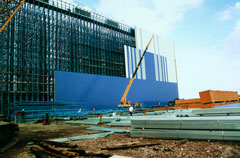Apr 27 2010
Sandwich panels comprising two metal facings and a polyisocyanurate (PIR) rigid foam core have long been used for the efficient thermal insulation of large warehouses, cold stores and other industrial and administration buildings. Developers at Bayer MaterialScience have now come up with a new, more environmentally compatible PIR foam system with significantly enhanced fire behavior that has clear benefits over established systems, especially when it comes to smoke gas development.
 Sandwich panels comprising two metal facings and a polyiso-cyanurate (PIR) rigid foam core have long been used for the efficient thermal insulation of large warehouses, cold stores and other industrial and administration buildings. Developers at Bayer MaterialScience have now come up with a new PIR foam system with significantly enhanced fire behavior that has clear benefits over established systems, especially when it comes to smoke gas development.
Sandwich panels comprising two metal facings and a polyiso-cyanurate (PIR) rigid foam core have long been used for the efficient thermal insulation of large warehouses, cold stores and other industrial and administration buildings. Developers at Bayer MaterialScience have now come up with a new PIR foam system with significantly enhanced fire behavior that has clear benefits over established systems, especially when it comes to smoke gas development.
Metal-faced sandwich panels based on this new product class even achieve a B-s1,d0 classification in the DIN EN 13823 Single Burning Item (SBI) test, with s1 representing the lowest smoke gas development class and d0 indicating that there are no flaming droplets. In recent years, the SBI test has increasingly become a standard requirement in Europe for the fire and smoke behavior of building components. For example, the new European standard for sandwich panels - DIN EN 14509 - also uses SBI-based tests for fire classification purposes.
PIR metal-faced sandwich panels can be manufactured on continuous laminators. The PIR reaction mix is first laid down on one metal facing. It foams and immediately bonds with the second facing, which is applied from above. In this way the rigid foam core is bonded to the two facings in a shear-resistant manner. The finished sandwich panels are self-supporting, very strong and relatively light. A variety of profiling options and colored surface finishing of the facings offer a great deal of scope for designers. This is particularly important when the sandwich panels are used for the façades of administration buildings.
"The B-s1,d0 classification enables our customers to undertake construction projects that are subject to stringent requirements in terms of components’ fire and smoke behavior and where it was previously essential to use inorganic core materials based on mineral wool to achieve smoke class s1. The new development creates an additional market segment for polyurethane-based metal-faced sandwich panels," says Harald Wolf, head of Marketing for the Europe, Middle East and Africa (EMEA) region at BaySystems Insulation.
"It goes without saying that the PIR core is not the only factor enabling this classification to be achieved in the SBI test. The sandwich panel must also have an appropriate joint structure," explains Dr. Rolf Roers, who is responsible for metal composites in Bayer MaterialScience’s applications engineering division. "Nevertheless, the latest series of tests has shown that the new PIR class produces much better results and that a B-s1,d0 classification is possible if the chemical composition and panel structures are ideally matched," adds Roers.
The new PIR foam system is based on a polyester with an impressively eco-friendly manufacturing process. "Our innovative process significantly reduces the amount of by-products that are generated and subsequently have to be disposed of," continues Roers.
Because the insulating effect of PIR foams is much better than that of mineral wool, the wider range of applications benefits building users and the environment alike. For example, a layer of PIR ten centimeters thick has a heat transfer coefficient of around 0.25 W/m2K, whereas the value for equally thick mineral wool insulation is normally just 0.4 W/m2K. A rough estimate of what this difference means in terms of energy consumption can be made based on the example of a factory building. "Assuming the building has a floor area of 40 x 20 square meters and is 10 meters high, the annual amount of heating oil saved could be roughly 3,000 liters if both the walls and the roof are insulated with PIR metal-faced sandwich panels rather than panels of the same thickness based on mineral wool," explains Roers. This lower energy consumption also results in an equivalent reduction in carbon dioxide emissions.